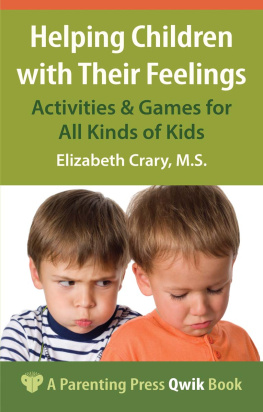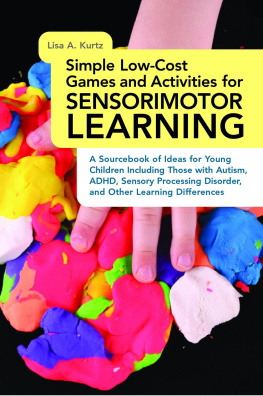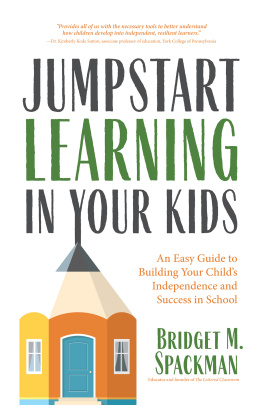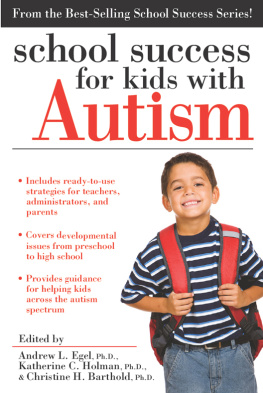
Contents
Note to Readers
Elizabeth Crary is well known for her work with parents and her many published books on helping children learn about feelings and social problem solving. Readers have asked for a short introduction on feelings that touches on the strategies she has developed. These strategies have been used successfully with both typical and atypical learners, even to the point of one childs diagnosis of autism being delayed by a couple of years because he dealt so well with his feelings.
You will find content from some of her books and card decks that can be used in a step-by-step process to teach your child about feelings at the childs pace from infancy into early elementary age. You can use this Qwik Book as a beginning guide in how to help your child gain emotional literacy. More in-depth information is available in the books mentioned in the Resources for those who wish it.
~ Parenting Press
Copyright 2014 by Elizabeth Crary
All rights reserved. No part of this book may be reproduced in any form without permission from Parenting Press, Inc.
Printed in the United States of America
ISBN 978-1-936903-14-6 paperback
Parenting Press | P.O. Box 75267 | Seattle, Washington 98175
www.ParentingPress.com
Book distribution through Independent Publishers Group at www.ipgbook.com and 800-888-4741
Introduction
Welcome to a Qwik Book overview of helping children with their feelings. Helping kids learn about their feelings can take from several months to several years depending on a childs characteristics and skill level. While children generally move along a predictable developmental path, each child is unique and moves at his or her own pace. Be assured that however much time you need to spend on helping your child learn about feelings will be invaluable to your childs personal and social progress.
Children develop the ability to feel and recognize feelings by interacting with other people. They need this interaction from the day they are born. Following a typical developmental path, children between birth and three years show tremendous growth in knowledge about feelings. For children who are not typical, the path may be longer and that is okay.
Six-week-old Aisha is focused on her grandfathers voice and face as he leans over her carrier, waggling his finger at her and talking animatedly. Her arms and legs are churning and her mouth is puckered up. She looks like she is about to explode with excitement!
Important things to know
Temperament affects how children feel and how they show feelings. When you understand a childs temperament, your guidance of the child will be easier. See Temperament Tools: Working with Your Childs Inborn Traits by Helen F. Neville, B.S., R.N., and Diane Clark Johnson.
Stages of physical, mental, and emotional development also affect what your child knows and is ready to learn now. It is important to have realistic expectations so that you expect neither too much nor too little. See Is This a Phase? Child Development & Parent Strategies, Birth to 6 Years by Helen F. Neville, B.S., R.N.
State of health and presence of disabilities affect how easily a child will learn. It may be hard for some children to learn to recognize feelings. If your child has been diagnosed with a disability, learn all you can about its effects so that you understand where to direct your and the childs efforts. Also, remember to pay attention to your own instincts about your childs needs. See The Learning Tree: Overcoming Learning Disabilities From the Ground Up by Stanley I. Greenspan, M.D., and Nancy Thorndike Greenspan.
Biology is not destiny if we detect problems early and give children extra practice with those skills that dont come easily.
~ Stanley I. Greenspan, M.D.
Family lifestyle affects how well children lay the foundation for understanding emotions and social communication. Parents long work hours, physical, financial, or emotional stresses, and amount of time with electronic devices (television, computers, phones, gaming devicesanything with a screen) all mean there is less relaxed time for playing with and guiding the children in the family. See Different Learners: Identifying, Preventing, and Treating Your Childs Learning Problems by Jane M. Healy, Ph.D.; also Back to Normal: Why Ordinary Childhood Behavior Is Mistaken for ADHD, Bipolar Disorder, and Autism Spectrum Disorder by Enrico Gnaulati, Ph.D.
Teachers of young children are noticing alarming numbers of kids who do not have basic behavioral or communication skills when they arrive at preschool or kindergarten. They feel the kids need more pretend play with lots of talking. More daily conversations with adults about experiences and how we feel about them. And many W questions: Why What When Where ? to get them feeling, thinking, and talking. Instruction in the basics of pleasant interaction, such as please and thank you, sharing, taking turns, making amends, and understanding anothers point of view would also be very helpful, they say. Most of these aids to social interaction require some knowledge of feelings.
Challenges to a childs understanding feelings
Before starting any of the feelings activities, think of the most effective way, time, and place to interact with your child. Children are different in temperament, preferences, abilities, developmental levels, and experience. You want to choose the most effective ways to get and keep your childs attention.
Sensory sensitivities. Any child can have sensory sensitivities, either because of temperament or a disability. If your child tends to be overwhelmed or turned inward by light, temperature, texture, sound, visual, or motion stimulation, or too many people around, make needed adjustments to the environment so that learning is easier. Consider such sensitivities as a possible reason for your childs refusal to cooperate and have unexplained tantrums or seem to withdraw from human companionship.
Make the environment as quiet as possible so the childs brain is not overwhelmed and can focus. For example, if noise is a problem, get rid of it. Turn off electronics, put the cat and dog out, work when other children are gone or asleep. If visual chaos is a problem, empty the room of most of whats in it and on the walls. If quick or sudden movement is the problem, plan to move and speak slowly and quietly with comments in advance about changes.
Temple Grandin, Ph.D., noted for her work in animal science and a spokesperson for people who have autism as she does, states that sensory problems in children with autism are real, common, and require attention. They can be enormously disabling. Instead of focusing only on autistic peoples having appropriate emotional responses to other people, she speculates that if more researchers directed their efforts at solving sensory problems, many of the emotional relatedness problems would disappear.
Refusal to look at your face. This may be disinterest or it may be because faces are too stimulating and confusing. Faces can change so quickly. Find an alternate route to your childs attention, perhaps through pictures or photographs. Say the childs name first and then use a compelling voice to interest your child in the activity even if he is not looking directly at you.
Short attention span. Most young children have short attention spans (by themselves: 30 seconds at 18 months; 30-60 seconds at 2 years; 2 minutes at 2.5 years; 3-8 minutes at 3 years; slightly longer at each age if interacting with someone else [See
Next page











